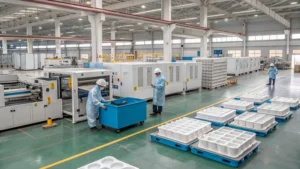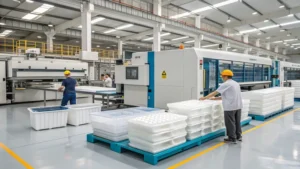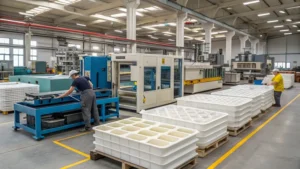
The shift towards lighter, more durable extruded products1 is reshaping industries worldwide, driven by the need for efficiency, sustainability, and enhanced performance. Extrusion, a process where materials like metals, plastics, or composites are forced through a die to create specific shapes, has evolved significantly. Thanks to advancements in materials—such as aluminum and composites—and cutting-edge extrusion technologies, these products now offer reduced weight without sacrificing strength, meeting the demands of modern applications.
Extrusion creates products by forcing materials through a die, and recent innovations have made them lighter and more durable, benefiting industries like automotive, aerospace, and construction.
In this article, we’ll unpack the reasons behind this shift, explore where these products are applied, and dive into the technical details that make them exceptional. We’ll also provide practical tools to help you decide if extruded products are right for your needs, along with insights into their role in the broader manufacturing ecosystem.
The shift towards lighter, more durable extruded products is primarily driven by industry needs for efficiency and sustainability.True
Industries like automotive and aerospace require materials that reduce energy consumption and environmental impact, which lighter and more durable extruded products provide.
Extruded products are only used in niche markets.False
Extruded products are widely used across industries such as automotive, aerospace, construction, and packaging due to their versatility and performance benefits.
- 1. What Are Extruded Products and Why Are They Becoming Lighter and More Durable?
- 2. Why Is There a Shift Towards Lighter, More Durable Extruded Products?
- 3. Where Are These Products Used?
- 4. How Does the Extrusion Process Work?
- 5. What Are the Pros and Cons of Extruded Products Compared to Other Technologies?
- 6. How to Choose the Right Extrusion Process for Your Needs?
- 7. What Are the Related Technologies to Extrusion?
- 8. Conclusion
What Are Extruded Products and Why Are They Becoming Lighter and More Durable?
Extruded products are manufactured by pushing materials—such as aluminum, plastics, or composites—through a die to form continuous, uniform shapes like tubes, rods, or profiles. Historically valued for their efficiency, these products are now becoming lighter and more durable due to innovations in material science and extrusion techniques. This evolution allows industries to achieve better performance while reducing resource use.

Advancements in materials like aluminum and composites, paired with improved extrusion technologies, enable the production of lighter, more durable products tailored to modern demands.
| Material Type | Recommended Applications | Notes |
|---|---|---|
| Aluminum | Automotive, Aerospace | Lightweight, corrosion-resistant |
| Plastics | Packaging, Construction | Versatile, cost-effective |
| Composites | Sports Equipment, Automotive | High strength-to-weight ratio |
Aluminum in Extrusion
Aluminum stands out in extrusion for its low density and resistance to corrosion. It’s a go-to material in automotive and aerospace sectors, where reducing weight boosts fuel efficiency and performance. For instance, aluminum extrusions2 in car frames or airplane wings cut weight while maintaining structural integrity.
Plastics and Composites
Plastics like polyethylene and polypropylene are extruded for packaging and construction, offering flexibility and affordability. Composites, blending materials like carbon fiber with resins, shine in sports equipment and automotive parts, delivering exceptional strength without added heft. These material choices reflect a balance of weight, durability, and cost suited to specific uses.
Aluminum is a preferred material for extruded products in industries requiring lightweight solutions.True
Aluminum’s low density and high strength make it ideal for applications where weight reduction is critical.
Extruded products made from plastics are less durable than those made from metals.False
Advancements in plastic materials and composites have led to extruded products that are both lightweight and highly durable.
Why Is There a Shift Towards Lighter, More Durable Extruded Products?
This shift is fueled by a trio of powerful drivers: efficiency, sustainability, and performance. Lighter products cut energy use in transportation and manufacturing, while durability extends lifespans, reducing waste and costs. These benefits align with both industry goals and consumer expectations.

Industries adopt lighter, more durable extruded products to enhance fuel efficiency, lower environmental impact, and meet demand for sustainable, high-performance solutions.
Efficiency and Sustainability
In automotive and aerospace, lighter materials translate to better fuel economy and lower emissions. For example, aluminum extrusions can slash vehicle weight by up to 30%, boosting mileage significantly. In construction, lightweight extruded components simplify handling and installation, cutting energy use on-site.
Consumer Demand for Sustainability
Consumers increasingly favor eco-friendly, long-lasting products. Lighter, durable extruded items—like sports gear or recyclable packaging—fit this bill, offering sustainable alternatives3 that don’t compromise quality. This trend mirrors a broader societal push towards greener living.
The shift towards lighter extruded products is solely due to cost savings.False
While cost savings are a factor, the primary drivers are efficiency, sustainability, and performance improvements.
Consumer preferences have no impact on the adoption of lighter, more durable extruded products.False
Consumer demand for sustainable and high-performance products is a significant factor in this shift.
Where Are These Products Used?
Lighter, more durable extruded products shine across diverse industries, from high-tech sectors like aerospace to everyday applications like packaging. Their ability to combine weight reduction with strength makes them indispensable.

These products enhance automotive parts, aerospace components, construction materials, sports equipment, and packaging, improving efficiency, handling, and shipping costs.
Automotive and Aerospace
In cars, extruded aluminum4 forms frames and panels, trimming weight for better mileage. In aerospace, it crafts aircraft structures, optimizing performance and fuel use. Both industries rely on these products to meet stringent efficiency standards.
Construction and Packaging
Construction benefits from extruded PVC pipes and aluminum profiles, which are easy to transport and install due to their lightweight durability. In packaging, extruded plastic films and containers cut shipping weight, aligning with sustainability goals while protecting goods.
Extruded products are only used in high-tech industries like aerospace.False
Extruded products are widely used in everyday applications, including construction and packaging, due to their versatility.
The use of extruded products in packaging reduces environmental impact.True
Lighter packaging materials reduce shipping weight, leading to lower fuel consumption and emissions.
How Does the Extrusion Process Work?
Extrusion is a continuous process that shapes materials by forcing them through a die. Key steps and material choices determine the lightness and durability of the final product.

The process involves feeding material into an extruder, melting or plasticizing it, shaping it through a die, cooling it, and finishing it to achieve desired properties.
Key Steps in Extrusion
-
Material Feeding: Raw materials (e.g., plastic pellets or metal billets) enter the extruder.
-
Melting/Plasticizing: Heat transforms the material into a molten or pliable state, controlled by temperature.
-
Die Shaping: The material is pushed through a die, with pressure and speed shaping the output.
-
Cooling: The product solidifies, locking in its form.
-
Post-Processing: Cutting or finishing refines the product for use.
Material Impact
- Plastics: Thermoplastics like polyethylene extrude easily, yielding lightweight, durable items.

-
Metals: Aluminum uses hot extrusion, requiring high heat and pressure for strong, light parts.
-
Composites: Carbon fiber blends offer superior strength-to-weight ratios for specialized needs.
These variables ensure the process delivers products tailored to specific demands.
The extrusion process is only suitable for plastics.False
Extrusion is used for a variety of materials, including metals like aluminum and composites.
Temperature control is a key parameter in the extrusion process.True
Proper temperature control ensures material consistency and optimal flow through the die.
What Are the Pros and Cons of Extruded Products Compared to Other Technologies?
Extruded products have distinct advantages but aren’t a one-size-fits-all solution. Comparing them to other methods highlights their strengths and limits.

Extruded products excel in mass-producing uniform shapes but may lack the complexity of injection molding or additive manufacturing.
| Technology | Pros of Extruded Products | Cons Compared to Extruded Products |
|---|---|---|
| Injection Molding | Continuous production, less waste | Limited to simpler shapes, more post-processing |
| Forging/Casting | Better strength-to-weight for some shapes | Higher waste, shape limitations |
| Additive Manufacturing | Efficient for high volumes, uniform shapes | Less flexible for complex or custom parts |
Extruded products are always the most cost-effective option.False
While cost-effective for mass production, other technologies may be better for small batches or complex shapes.
Extruded products offer superior strength-to-weight ratios compared to forged or cast products.True
Advancements in materials like composites have made extruded products highly competitive in terms of strength and weight.
How to Choose the Right Extrusion Process for Your Needs?
Selecting the best extrusion approach requires weighing material, shape, and volume needs. A structured guide simplifies the decision.

A decision tree5 helps determine if extrusion fits your needs based on shape complexity, production volume, and material compatibility.
Decision Tree
-
Constant Cross-Section?
- Yes → Extrusion is efficient.
- No → Consider injection molding or casting.
-
High Production Volume?
- Yes → Extrusion shines in mass production.
- No → Additive manufacturing suits smaller runs.
-
Material Needs?
- Opt for aluminum or composites for lightweight durability, ensuring process compatibility.
This framework ensures you pick a process that aligns with your goals.
Extrusion is the best process for all manufacturing needs.False
Extrusion is ideal for specific applications but may not suit complex or low-volume production.
Material selection is critical in determining the success of the extrusion process.True
Different materials require specific adjustments to achieve desired properties.
What Are the Related Technologies to Extrusion?
Extrusion doesn’t operate in isolation—it’s part of a interconnected manufacturing web, from raw material production to final assembly.

Related technologies span material production, die manufacturing, post-processing, and parallel methods like injection molding.
Upstream and Downstream Links
-
Upstream: Polymer synthesis for plastics, metal refining for aluminum, precision die-making.
-
Downstream: Cutting, finishing, and integration into products like car parts or building materials.
-
Parallel: Injection molding for complex parts, blow molding for hollow items, thermoforming for sheets.
This network underscores extrusion’s role in modern manufacturing.
Extrusion is an isolated technology with no connections to other processes.False
Extrusion relies on upstream material production and downstream finishing processes.
Understanding related technologies can enhance the effectiveness of extrusion.True
Knowledge of the broader ecosystem optimizes extrusion’s integration and outcomes.
Conclusion
The shift towards lighter, more durable extruded products reflects a convergence of efficiency, sustainability, and performance needs. Innovations in materials like aluminum and composites, alongside refined extrusion6 techniques, have made these products vital across industries—from automotive to packaging. While ideal for mass production and uniform shapes, their limitations in complexity and customization warrant careful consideration. By grasping the process, applications, and related technologies, you can harness extruded products to meet your specific challenges effectively.
-
Explore the advantages of extruded products, including their efficiency and sustainability, to understand their impact on modern industries. ↩
-
Learn how aluminum extrusions contribute to fuel efficiency and performance in vehicles and aircraft, making them a key material in these industries. ↩
-
Explore this link to discover innovative sustainable alternatives that meet consumer demand and environmental goals. ↩
-
Find out how extruded aluminum contributes to better fuel economy and performance in automotive and aerospace applications. ↩
-
A decision tree can simplify complex manufacturing choices, making it easier to select the right process for your needs. ↩
-
Understanding the extrusion process is crucial for grasping its applications and benefits in various industries. ↩








